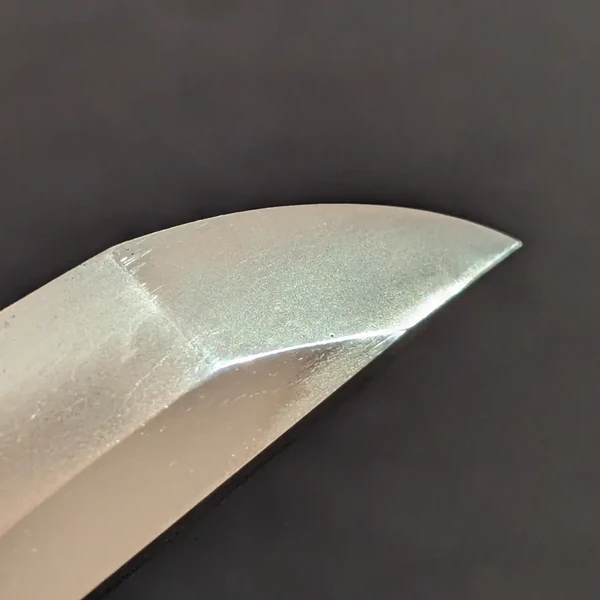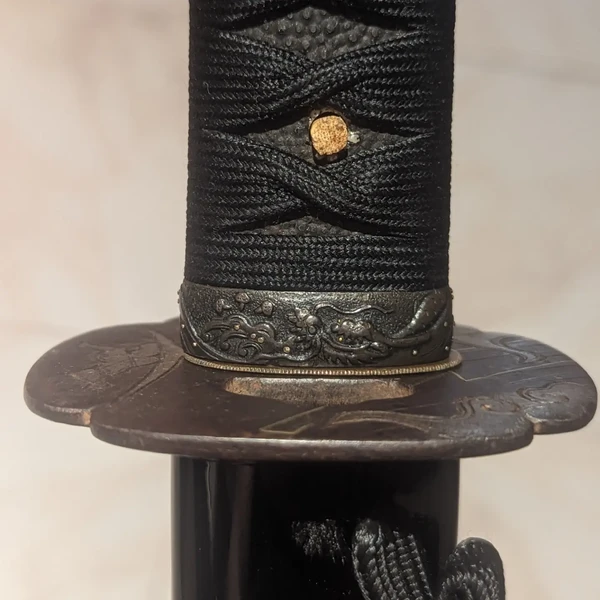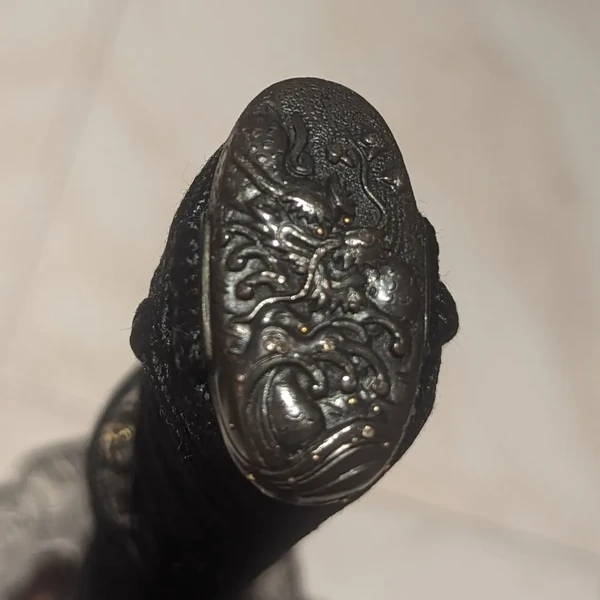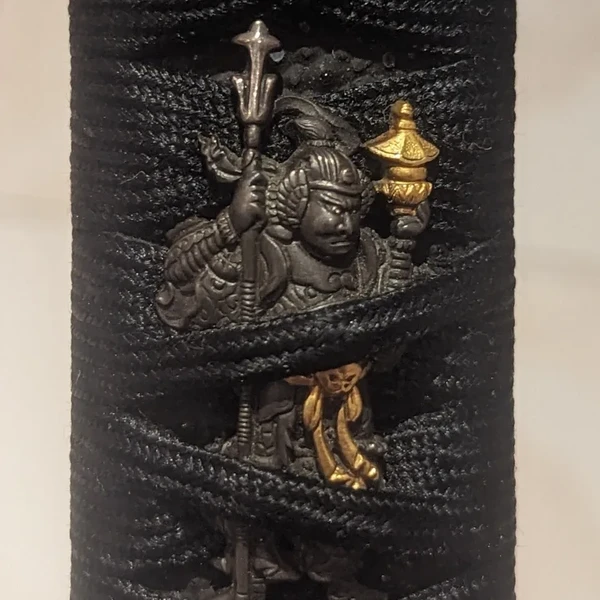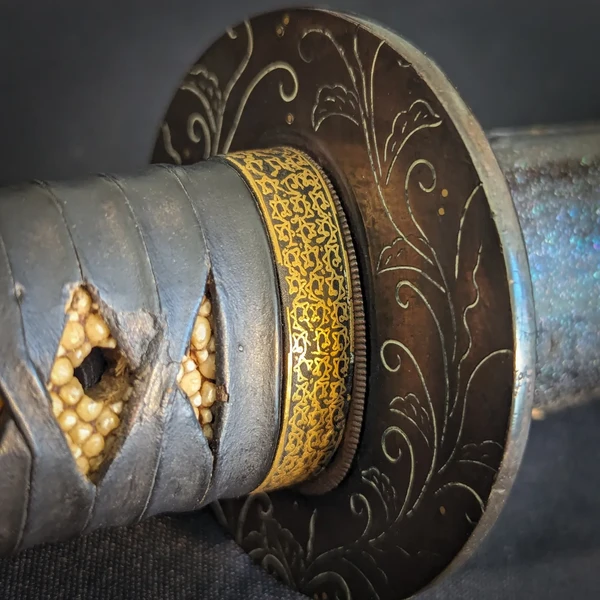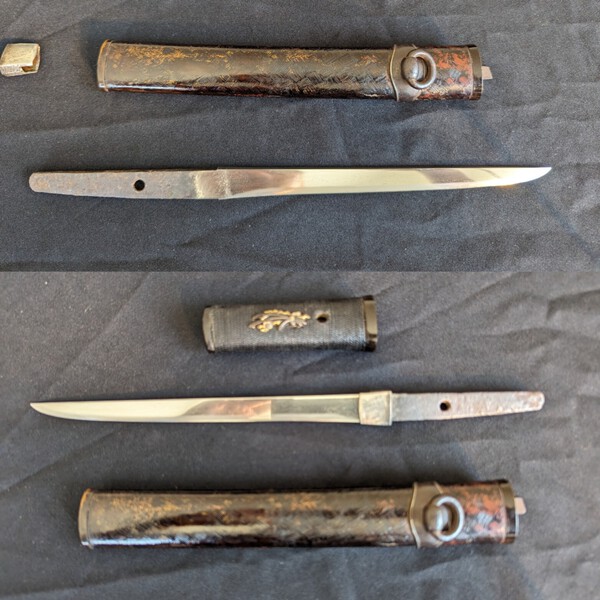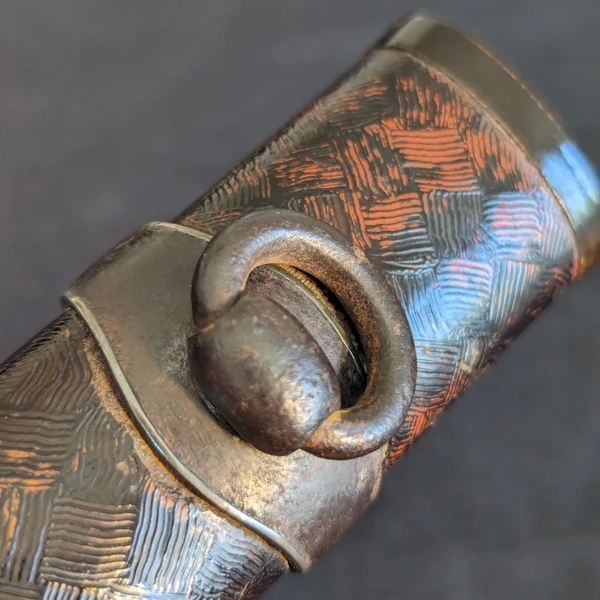-
Posts
4,966 -
Joined
-
Last visited
-
Days Won
133
Everything posted by Ray Singer
-
坂倉言之進照包 - Sakakura Gonnoshin Terukane
-
This is a very nice katana in koshirae with an NBTHK Hozon certificate attributing it to Echizen Seki (a school dating from late Koto into Shinto times). https://swordsofjapa...echizen-seki-katana/ Echizen province is in present day Fukui prefecture on the western coast of Japan. The Echizen Seki school was one of the two principal schools of sword smithing in Echizen, the other being the Yasutsugu who were originally from Omi province. The Echizen Seki were created by smiths moving from seki to Echizen. and were particularly active from 1658 -1680. This is a nice long blade with a low choji-midare hamon. Black tsuka wrap with very high quality Nio (temple guardian) menuki. The menuki has an NBTHK Hozon certificate. Iron jingo tsuba and shakudo dragon fuchigashira. Black lacquer scabbard. copper habaki. Hamon: Gunome-choji some togari-gunome, in nie-deki Jitetsu: itame with mokume mix. blade has muneyaki Boshi: ko-maru Nakago : 21.1 cm Nagasa: 70. 0 cm Moto-haba : 2.9 cm saki-haba: 2.1 cm moto-kasane: 0.6mm Saki-kasane: 0.5mm Kissaki: 3.2cm $4k + shipping and PayPal
-
- 2
-

-

Help with a translation on a WW2 sword.
Ray Singer replied to Bill K's topic in Translation Assistance
Okada Kanesada saku. https://www.warrelic...e-sword-tang-823682/ -

Real or fake? Translation needed
Ray Singer replied to William Jennings's topic in General Nihonto Related Discussion
Ujifusa was a lineage of Owari smiths. Yes, this appears to be Edo period and restorable, but that is a question best answered by a polisher evaluating the sword in hand. -

Real or fake? Translation needed
Ray Singer replied to William Jennings's topic in General Nihonto Related Discussion
Ujifusa. Authentic antique Japanese sword. -

Naminohira Yasumasa wakizashi in very nice koshirae
Ray Singer replied to Ray Singer's topic in Swords and Edged Weapons
Thank you for the catch Piers, I will update with the correct smith bio when I get off my flight. -
Ubu mumei Sue-koto wakizashi in shobu-zukuri form. Dragon fuchi in shakudo, horn kashira and mitsudomoe kamon menuki. Copper falling rain yasurimei tsuba. The blade is not in polish, but a notare hamon can vaguely be seen. Blade is third from the left in the group photo, but I will provide additional detail photos later today. $850 (plus shipping and PayPal)
-
Nicely mounted Shinto wakizashi from the Naminohira school. Hamon is gunome-midare in with a lot of togari, like Mino work. Fuchigashira are iron with brass karakusa. The tsuba has a karakusa design as well. Menuki are shakudo water dragons, against a nice quality same. Tsukamaki is leather. Saya is done in lacquer with crushed abalone. Sageo added as well. $1,250 (plus shipping and PayPal)
-

Shinshinto boy's day sword in partial koshirae
Ray Singer posted a topic in Swords and Edged Weapons
A boy's day sword, shinshinto blade with a nice fujisan habaki. With koshirae having a iron wisteria sukashi tsuba, shakudo fuchi and hawk kozuka. Menuki and kashira are missing. The blade has a shallow hakobore in the monouchi but the hamon is very wide in that area (a gunome-midare with paired gunome formations). $950 (plus shipping and PayPal) -
Muromachi period Tosa Yoshimitsu yoroidoshi, armour piercing tanto with koshirae. Iron fittings and a brushed lacquer texture saya with small iron umabari. Floral shakudo menuki. Current NBTHK Hozon kanteisho with a earlish torokusho date stamp of Showa 29. Beautiful itame-nagareru, with larger areas of mokume. Ubu nakago. $2,975 (plus shipping and PayPal)
-
Comment removed. I spoke with Jimi directly.
-
That's it, thank you Chris.
-
Hi Chris, I saw and commented on that as well. Do you happen to have a link for the one that recently sold on aoijapan.com? As I recall it was also in a very good condition shingunto koshirae with general tassel. Unfortunately I did not save the link. Best regards, Ray
-

Need help to translate Star Stamp Showa Sword
Ray Singer replied to War Time's topic in Translation Assistance
Noshu ju Kanenobu, dated 1945 -
My impression is that his work is rarely seen. That said, another below. https://aucview.aucf...m&tg=detailtextModal
-
https://aucview.aucf...om/yahoo/c812336278/
-
It's simply not possible to give an estimated value based on this one photo alone, please show clear photos of the blade itself.
-
I suspect the original reading was 當麻 - Taima, however the kinpun-mei (gold lacquer inscription) has degraded over time. The blade predates World War II, and appears to be Edo period work.
-

Which WAKIZASHI/Which katana to pick
Ray Singer replied to Ronald Aguirre's topic in General Nihonto Related Discussion
It's really difficult for me to make any type of determination on these based on the photos Ronald, as I said above. I'm just letting you know that, based on a little information that's here, the one that I highlighted seems to show the most potential and is the most interesting. -

Which WAKIZASHI/Which katana to pick
Ray Singer replied to Ronald Aguirre's topic in General Nihonto Related Discussion
A number of these appear to be koto including this one in the middle with horimono. It has a Nobukuni look, and that's the one I would pursue first. -

Which WAKIZASHI/Which katana to pick
Ray Singer replied to Ronald Aguirre's topic in General Nihonto Related Discussion
And I don't think it would be possible for anyone here to make a valid recommendation on which of these swords to polish based on the photos above. Very little can be seen, and there's no way to make an assessment on how well any of them will sustain a restoration based on those photos. It is regardless something that's better determined by a professional polisher looking at the sword in hand. -

Which WAKIZASHI/Which katana to pick
Ray Singer replied to Ronald Aguirre's topic in General Nihonto Related Discussion
Is your intention to purchase the sword and have it restored professionally? I'm asking because most often swords that are found in poor condition are not worthwhile Investments to have restored. There's nothing wrong with doing so to save a sword, but also be aware that the investment does not always increase the value of the sword above what you have paid for in restoration.





